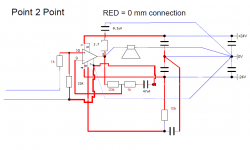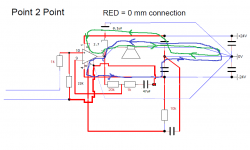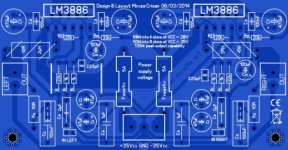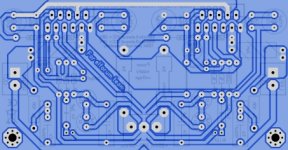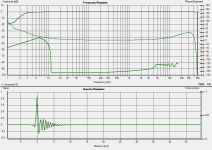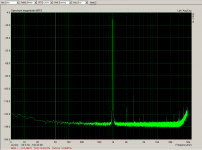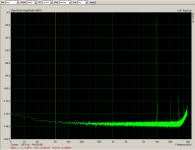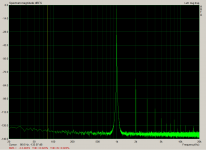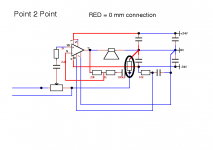Hi wintermute,
I think this is close to what you made. Some interesting choices.
Hi Mark, probably closest to this:
Tony.
Attachments
On PSSR, it seems to work extremely well. In simulations I could not distort the output signal and I really tried. I even connected an AC source directly to the output. It seemed to have no impact on the output signal.
I am mostly interested in the caps impact on LF signals. This is one of the most reported "improvements" at DiyAudio.
I am mostly interested in the caps impact on LF signals. This is one of the most reported "improvements" at DiyAudio.
well think about it,
no it's not for me personally but for the whole DIY community
It's still at least two hours of work for me for just one measurement. Two hours I'd rather spend making progress on my own projects. However, should you decide to make that contribution to the DIY community yourself, I will gladly participate on your "how do I make this measurement" thread.
There will always be "so-and-so on the Internet says" myths. Can't debunk them all.
BTW my bill is in the mail.
Sweet! So is my check...
~Tom
On PSSR, it seems to work extremely well. In simulations I could not distort the output signal and I really tried. I even connected an AC source directly to the output. It seemed to have no impact on the output signal.
Supply effects do not appear to be modeled is the LM3886 model. I have no idea why...
I can measure the PSRR on my setup from, say, 1 Hz or 10 Hz to 100 kHz (test equipment limit). I'll see if I can get that done tonight.
~Tom
sure I'll do right after my Agilent spectrum analyzer arrives.
All you need is a sound card and some software. A stand-alone analyzer just makes it easier (especially for automated sweeps).
~Tom
Hi Mark, probably closest to this:
As far as I know, if sch replicate real thing, this is completely wrong, HF loop in both direction is huge! Input, feedback and output ground should be referenced to power ground point which is form by local decoupling caps near the power supply pins, 'cos that is the point from where the amp gets it's ground reference.
Attachments
All you need is a sound card and some software. A stand-alone analyzer just makes it easier (especially for automated sweeps).
~Tom
yeah I forget about that
I will look into a cheap external sound card, but my instincts tell me I'll have common mode issues with single ended amps esp for low level PSRR measurements.
is this something you have done?
Have a look here: Sound Card Interface. Don't go too cheap on the sound card. Some of the stuff you want to measure is 80~100 dB down from the fundamental. You need a sound card with decent dynamic range and low noise floor. A good sound card should beat the performance of my HP8903A distortion analyzer without breaking a sweat.
Personally, I prefer the stand-alone equipment. I like having a knob to turn rather than having to click with a mouse. I also like having the ability to remote control the equipment through HPIB and have a script run for 20 minutes collecting data while I go do something else.
I managed to pick up quite a few pieces of gear during the credit crunch when companies were laying off employees left and right and had to liquidate the gear. Most of my gear has set me back less than $150 apiece, shipped. Some of it was free (but needed repair). Much of it was defective but I repaired it and ran it through the calibration procedure using the much better gear I have access to at work. I do have two more expensive analyzers - one HP3563A dynamic signal analyzer and an HP3577A on its way from California. Even those set me back less than what many people I know pay for six months of cable TV and cell phone service.
~Tom
Personally, I prefer the stand-alone equipment. I like having a knob to turn rather than having to click with a mouse. I also like having the ability to remote control the equipment through HPIB and have a script run for 20 minutes collecting data while I go do something else.
I managed to pick up quite a few pieces of gear during the credit crunch when companies were laying off employees left and right and had to liquidate the gear. Most of my gear has set me back less than $150 apiece, shipped. Some of it was free (but needed repair). Much of it was defective but I repaired it and ran it through the calibration procedure using the much better gear I have access to at work. I do have two more expensive analyzers - one HP3563A dynamic signal analyzer and an HP3577A on its way from California. Even those set me back less than what many people I know pay for six months of cable TV and cell phone service.
~Tom
Last edited:
As far as I know, if sch replicate real thing, this is completely wrong, HF loop in both direction is huge! Input, feedback and output ground should be referenced to power ground point which is form by local decoupling caps near the power supply pins, 'cos that is the point from where the amp gets it's ground reference.
You don't like it? Most of the designs here at Diyaudio use this method of speaker return (grounding), including the great My_Ref_c.
As far as I know, if sch replicate real thing, this is completely wrong, HF loop in both direction is huge! Input, feedback and output ground should be referenced to power ground point which is form by local decoupling caps near the power supply pins, 'cos that is the point from where the amp gets it's ground reference.
I did it based on the datasheet comment here:
When designing a layout, it is important to return the load ground, the output compensation ground, and the low
level (feedback and input) grounds to the circuit board common ground point through separate paths. Otherwise,
large currents flowing along a ground conductor will generate voltages on the conductor which can effectively act
as signals at the input, resulting in high frequency oscillation or excessive distortion. It is advisable to keep the
output compensation components and the 0.1 μF supply decoupling capacitors as close as possible to the
LM3886 to reduce the effects of PCB trace resistance and inductance. For the same reason, the ground return
paths should be as short as possible.
The only thing (as far as I can see) that I have not done in accordance with this is keeping the star point as close as possible to the chip ie "For the same reason, the ground return paths should be as short as possible".... This is the thing that Tom mentioned as well and the part I thought I should change. This is a minor change in that I just have to shorten the four earth return leads and tie them to a common point and then run a single lead from their back to the PSU ground point.
Or am I missing something else?
Tony.
yeah I forget about that
I will look into a cheap external sound card, but my instincts tell me I'll have common mode issues with single ended amps esp for low level PSRR measurements.
is this something you have done?
I have a focusrite scarlet 2i2. It is pretty good on balanced to balanced loopback. It is very ordinary when an unbalanced device is connected to the balanced output (distortion is MUCH higher). I intend to make a balanced to unbalanced converter, some of the chips are ok but generally only have S/N of about -100db. I'd like to get something -120DB. I did find one chip but can't remember what it was, was SMD only Linear Technology I think. Found someone who had used it and was getting better than -120db S/N.
Attached are tests I did when I first got the 2i2, note the distortion plot in holm is suspect. 4th pic is using a balanced to unbalanced loopback. ie: unbalced out (tip hot, ring and shield tied together) , and then tip and shield of the RCA to tip and ring on the input of the 2i2
Tony.
Attachments
Last edited:
Hi Wintermute, I would connect the feedback loop to 0V (star). after tomchr tested different return methods, I realised how bad it is not to return the feedback and audio returns separately to star.
The feedback loop becomes a voltage divider and so injects output signal into the audio return, as well as messing up the feedback loop.
See schematic.
The feedback loop becomes a voltage divider and so injects output signal into the audio return, as well as messing up the feedback loop.
See schematic.
Attachments
Last edited:
Personally, I prefer the stand-alone equipment. I like having a knob to turn rather than having to click with a mouse.
~Tom
Yeah me too. I was spoiled with good gear at work. I was chained up to a HP8566 (Cadillac of the day) in a screen room for years. eg Avionics EW Comms hopping frequency sources. Lots of high speed digital too. I did some early hobby PC sound card stuff with loop back and had some problems with ext. grounding so kind of let it go at that point.
jealous of all your test eq. collections. will start looking at PC stuff again.
I have a focusrite scarlet 2i2. It is pretty good on balanced to balanced loopback. It is very ordinary when an unbalanced device is connected to the balanced output (distortion is MUCH higher).
Tony.
Hi Tony that looks pretty nice. what software are you running? I guess getting some measurement software is key, which then determines the interface hardware / sound card requirements. yes I think balanced interfaces are necessary will look into that some more
I have a focusrite scarlet 2i2.
I like it. I have the Saffire PRO 24 myself. Nice box.
what software are you running?
Looks like Holm Impulse and ARTA to me. Holm Impulse is free. ARTA is $80 or maybe it's 80 Euro. Pretty reasonable. There are free audio spectrum analyzer software as well. If you find any for Mac, let me know.
~Tom
- Home
- Amplifiers
- Chip Amps
- LM3886 PCB vs Point-to-Point (with data)
